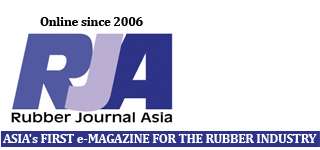Despite the fall of output of natural rubber in 2014, its consumption saw a year-on-year growth of 6.8 % to 12.16 million tons, fuelled mainly by the global tyre market.
Global natural rubber market (consumer) is primarily concentrated in China, India, Europe, Japan, etc. China is the world’s largest consumer of natural rubber, guzzling 4,760 kt in 2014, representing a year-on-year rise of 13.1%, making up 39.1% of the world’s total consumption. Pulled by the demand from automobile and tyre industries in China, natural rubber consumption will continue to grow and is expected to reach 6,791 kt by 2018.
However, limited by unfavorable weather conditions, the output of natural rubber market in China is rather low, only 857 kt in 2014, or 7.1% of the global total. In order to meet supply-demand gap, China has to import a large amount of natural rubber from Thailand, Indonesia and Malaysia, with imports reaching 2,610 kt in 2014, 54.8% of total consumption that year. At present, Sri Trang Agro-Industry Plc., Von Bundit and Thai Hua Rubber are major global natural rubber producers. They have, by virtue of their resource advantages, continued to boost planting and production capacity. Von Bundit is the company with the largest natural rubber capacity in the world. It has production bases in Thailand, Singapore, etc. By the end of 2014, the company boasted annual capacity of 1,650 kt.
The 10 companies profiled in this natural rubber market report include Sri Trang Agro-Industry Plc., Thai Rubber Latex Corporation (Thailand) Public Co., Ltd. (TRUBB), Thai Hua Rubber Public Co., Ltd., Von Bundit Co., Ltd., Southland Rubber Co., Ltd. (all global players) as well as Chinese players like China Hainan Rubber Industry Group Co., Ltd. (601118), Sinochem International Corporation (600500), Yunnan State Farms Group Co., Ltd., Guangdong Guangken Rubber Group Co., Ltd. and Yunnan Gaoshen Rubber Co., Ltd. Order a copy of Global and China Natural Rubber Market Report, 2014-2018 at http://www.rnrmarketresearch.com/contacts/purchase?rname=408886 .
Sri Trang Agro-Industry Plc. is the world’s second largest natural rubber producer. By the end of 2014, it had set up 26 plants in Thailand and Malaysia, totaling a capacity of 1,400 kt/a. The company’s processing plant in Burma will go into production at the end of 2015, then adding natural rubber capacity of 100 kt/a.
Meanwhile, major Chinese natural rubber market producers, including Sinochem International, Guangdong Guangken Rubber Group and China Hainan Rubber Industry Group, are actively developing new products and speeding up the implementation of “going out” strategy.
Sinochem International Corporation is the largest supplier of natural rubber in China. By the end of 2014, the company had 23 processing plants in 8 main rubber producing countries with total annual capacity of 730 kt, including a capacity of 36 kt/a added in Africa.
China Hainan Rubber Industry Group Co., Ltd. is the largest natural rubber producer in China. As of the end of 2014, the company had the planting area of 3.53 million mu (1mu equals to about 1/15 hectare). In Jul 2015, the natural rubber material for domestic military aircraft tyre jointly developed by the company and Shuguang Rubber Industry Research and Design Institute of China National Tyre Rubber Corporation passed technical evaluation, breaking monopoly of imported high-end products in military aircraft tyre in China.
Guangdong Guangken Rubber Group Co., Ltd. began to expand its overseas business from 2004. In May 2015, the company added 1,500 hectares of rubber planting area with operation period of 60 years, further expanding its natural rubber market planting territory.
The second and related research titled Global and China Tyre Industry Report, 2014-2015 [http://www.rnrmarketresearch.com/global-and-china-tyre-industry-report-2014-2015-market-report.html ] says declining price in natural rubber market helped substantial cost reduction of tyre vendors; the tyre price was more stable than the costs although it did drop. Despite the shrunk revenue in 2014, almost all tyre producers saw higher profit margins. This situation continues in 2015, reflected in the falling price in natural rubber market and the slight decline in the tyre price. What comes to the momentous event in the tyre industry in 2015 is that the state-owned Sinochem is probable to acquire the shares of the world’s fifth largest tyre company — Pirelli to demonstrate the strength of China in the capital field, which is a blockbuster in the tyre industry. For a long time, Chinese tyre makers have not found a way into the field of sedan OE Tyres, so they primarily target RT and truck tyre markets. Pirelli is the most important tyre supplier for BMW, and the second largest supplier for Mercedes-Benz, also one of Ford’s main suppliers. Through the acquisition of Pirelli, Chinese vendors have begun to supply OE Tyres for luxury cars.
In future, Chinese companies may make more acquisitions to expand the market, obtain technologies and avoid the anti-dumping investigation of the United States. Finland-based Nokian, America-based Titan and CTP, Russia-based Nizhnekamskshina and OJSC, as well as Belarus-based JSC Belshina Belarus are likely to be potentially taken over. If Chinese companies take over Nokian, they will seize the excellent winter tyre technology.

